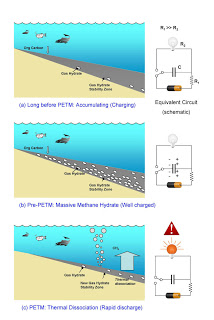
The release of massive amounts of carbon from methane hydrate frozen under the seafloor 56 million years ago has been linked to the greatest change in global climate since a dinosaur-killing asteroid presumably hit Earth 9 million years earlier. New calculations by researchers at Rice University show that this long-controversial scenario is quite possible.
Nobody knows for sure what started the incident, but there’s no doubt Earth’s temperature rose by as much as 6 degrees Celsius. That affected the planet for up to 150,000 years, until excess carbon in the oceans and atmosphere was reabsorbed into sediment.
Earth’s ecosystem changed and many species went extinct during the Paleocene-Eocene Thermal Maximum (PETM) 56 million years ago, when at least 2,500 gigatonnes of carbon, eventually in the form of carbon dioxide, were released into the ocean and atmosphere. (The era is described in great detail in a recent National Geographic feature.)
A new report by Rice scientists in Nature Geoscience suggests that at the time, even though methane-containing gas hydrates — the “ice that burns” — occupied only a small zone of sediment under the seabed before the PETM, there could have been as much stored then as there is now.
This is a concern to those who believe the continued burning of fossil fuels by humans could someday trigger another feedback loop that disturbs the stability of methane hydrate under the ocean and in permafrost; this change could warm the atmosphere and prompt the release of large amounts of methane, a more powerful greenhouse gas than carbon dioxide.
Some who study the PETM blame the worldwide burning of peat, volcanic activity or a massive asteroid strike as the source of the carbon, “but there’s no crater, or any soot or evidence of the burning of peat,” said Gerald Dickens, a Rice professor of Earth science and an author of the study, who thinks the new paper bolsters the argument for hydrates.
The lead author is graduate student Guangsheng Gu; co-authors are Walter Chapman, the William W. Akers Professor in Chemical Engineering; George Hirasaki, the A.J. Hartsook Professor in Chemical Engineering; and alumnus Gaurav Bhatnagar, all of Rice; and Frederick Colwell, a professor of ocean ecology and biogeochemistry at Oregon State University.
In the ocean, organisms die, sink into the sediment and decompose into methane. Under high pressure and low temperatures, methane molecules are trapped by water, which freezes into a slushy substance known as gas hydrate that stabilizes in a narrow band under the seafloor.
Warmer oceans before the PETM would have made the stability zone for gas hydrate thinner than today, and some scientists have argued this would allow for much less hydrate than exists under the seafloor now. “If the volume — the size of the box — was less than today, how could it have released so much carbon?” Dickens asked. “Gu’s solution is that the box contains a greater fraction of hydrate.”
“The critics said, ‘No, this can’t be. It’s warmer; there couldn’t have been more methane hydrate,'” Hirasaki said. “But we applied the numerical model and found that if the oceans were warmer, they would contain less dissolved oxygen and the kinetics for methane formation would have been faster.”
With less oxygen to consume organic matter on the way down, more sank to the ocean floor, Gu said, and there, with seafloor temperatures higher than they are today, microbes that turn organic matter into methane work faster. “Heat speeds things up,” Dickens said. “It’s true for almost all microbial reactions. That’s why we have refrigerators.”
The result is that a stability zone smaller than what exists now may have held a similar amount of methane hydrate. “You’re increasing the feedstock, processing it faster and packing it in over what could have been millions of years,” Dickens said.
While the event that began the carbon-discharge cycle remains a mystery, the implications are clear, Dickens said. “I’ve always thought of (the hydrate layer) as being like a capacitor in a circuit. It charges slowly and can release fast — and warming is the trigger. It’s possible that’s happening right now.”
That makes it important to understand what occurred in the PETM, he said. “The amount of carbon released then is on the magnitude of what humans will add to the cycle by the end of, say, 2500. Compared to the geological timescale, that’s almost instant.”
“We run the risk of reproducing that big carbon-discharge event, but faster, by burning fossil fuel, and it may be severe if hydrate dissociation is triggered again,” Gu said, adding that methane hydrate also offers the potential to become a valuable source of clean energy, as burning methane emits much less carbon dioxide than other fossil fuels.
The calculations should encourage geologists who discounted hydrates’ impact during the PETM to keep an open mind, Dickens said. “Instead of saying, ‘No, this cannot be,’ we’re saying, ‘Yes, it’s certainly possible.'”
The United States Department of Energy supported the research.
Note : The above story is reprinted from materials provided by Rice University.










